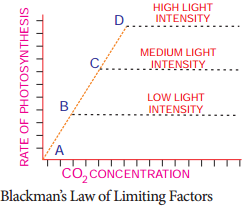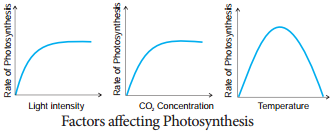Learninsta presents the core concepts of Biology with high-quality research papers and topical review articles.
Factors Affecting Photosynthesis
In 1860, Sachs gave three cardinal points theory explaining minimum, optimum and maximum factors that control photosynthesis. In 1905, Blackman put forth the importance of smallest factor. Blackman’s law of limiting factor is actually a modified Law proposed by Liebig’s Law of minimum. According to Blackman, “When a process is conditioned as to its rapidity by a number of separate factors, the rate of the process is limited by the pace of the lowest factor”.
To conclude in an easy way “at any given point of time the lowest factor among essentials will limit the rate of photosynthesis”. For example, when even sufficient light intensity is available, photosynthesis may be low due to low CO2 in the atmosphere.
Here, CO2 acts as a limiting factor. If CO2 is increased in the atmosphere the rate of photosynthesis also increases. Further increase in photosynthesis is possible only if the available light intensity is also increased proportionately (Figure 13.21).

Factors affecting photosynthesis are further grouped into External or Environmental factors and Internal factors.
I. External Factors:
Light, carbon dioxide, temperature, water, mineral and pollutants.
II. Internal Factors:
Pigments, protoplasmic factor, accumulation of carbohydrates, anatomy of leaf and hormones.
External Factors
1. Light
Energy for photosynthesis comes only from light. Photooxidation of water and excitation of pigment molecules are directly controlled by light. Stomatal movement leading to diffusion of CO2 is indirectly controlled by light.
a. Intensity of Light:
Intensity of light plays a direct role in the rate of photosynthesis. Under low intensity the photosynthetic rate is low and at higher intensity photosynthetic rate is higher. It also depends on the nature of plants. Heliophytes (Bean Plant) require higher intensity than Sciophytes (Oxalis).
b. Quantity of Light:
In plants which are exposed to light for longer duration (Long day Plants) photosynthetic rate is higher.
c. Quality of light:
Different wavelengths of light affect the rate of photosynthesis because pigment system does not absorb all the rays equally. Photosynthetic rate is maximum in blue and red light. Photosynthetically Active Radiation (PAR) is between 400 to 700 nm. Red light induces highest rate of photosynthesis and green light induces lowest rate of photosynthesis.
2. Carbon Dioxide
CO2 is found only 0.3% in the atmosphere but plays a vital role. Increase in concentration of CO2 increases the rate of photosynthesis (CO2 concentration in the atmosphere is 330 ppm). If concentration is increased beyond 500ppm, rate of photosynthesis will be affcted showing the inhibitory effect.
3. Oxygen
The rate of photosynthesis decreases when there is an increase of oxygen concentration. This Inhibitory effect of oxygen was first discovered by Warburg (1920) using green algae Chlorella.
4. Temperature
The optimum temperature for photosynthesis varies from plant to plant. Temperature is not uniform in all places. In general, the optimum temperature for photosynthesis is 25°C to 35°C. This is not applicable for all plants.
The ideal temperature for plants like Opuntia is 55°C, Lichens 25°C and Algae growing in hot spring photosynthesis is 75°C. Whether high temperature or low temperature it will close the stomata as well as inactivate the enzymes responsible for photosynthesis (Figure 13.22).

5. Water
Photolysis of water provides electrons and protons for the reduction of NADP, directly. Indirect roles are stomatal movement and hydration of protoplasm. During water stress, supply of NADPH + H+ is affected.
6. Minerals
Deficiency of certain minerals affect photosynthesis e.g. mineral involved in the synthesis of chlorophyll (Mg, Fe and N), Phosphorylation reactions (P), Photolysis of water (Mn and Cl), formation of plastocyanin (Cu).
7. Air pollutants
Pollutants like SO2, NO2, O3 (Ozone) and Smog affects rate of photosynthesis.
Internal Factors
1. Photosynthetic Pigments
It is an essential factor and even a small quantity is enough to carry out photosynthesis.
2. Protoplasmic Factor
Hydrated protoplasm is essential for photosynthesis. It also includes enzymes responsible for Photosynthesis.
3. Accumulation of Carbohydrates
Photosynthetic end products like carbohydrates are accumulated in cells and if translocation of carbohydrates is slow then this will affect the rate of photosynthesis.
4. Anatomy of Leaf
Thickness of cuticle and epidermis, distribution of stomata, presence or absence of Kranz anatomy and relative proportion of photosynthetic cells affect photosynthesis.
5. Hormones
Hormones like gibberellins and cytokinin increase the rate of photosynthesis.